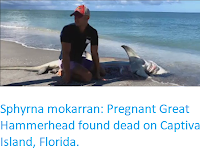Kitefin Sharks, Dalatiidae, are small Sharks with robust lower jaws, which lack spines in their dorsal fins and have no anal fins. They show heterodont dentition (the teeth are not all the same, in this case with the upper and lower teeth being distinct, and some species are bioluminescent. The group includes the distinctive Cookiecutter Sharks, Isistius spp., which feed by taking a circular (or cookie shaped) bite of flesh from prey animals much larger than themselves.
In a paper published in the journal Zootaxa on 18 June 2019, Mark Grace of the Mississippi Laboratories of the National Oceanic and Atmospheric Administration, Michael Doosey of the Tulane University Biodiversity Research Institute, John Denton of the Florida Program for Shark Research at the University of Florida, and the Department of Ichthyology at the American Museum of Natural History, Gavin Naylor also of the Florida Program for Shark Research at the University of Florida, Henry Bart, also of the Tulane University Biodiversity Research Institute, and John Maisey of the Department of Vertebrate Paleontology at the American Museum of Natural History, describe a new species of Kitefin Shark from the Gulf of Mexico.
The new species is placed in the Pocket Shark genus Mollisquama (so called because some species reach less than 40 cm in length, and the presence of a distinctive pocket-shaped gland above the pectoral fin), and given the specific name mississippiensis, meaning 'from Mississippi'. The species is described from an immature male specimen 142 mm in length and weighing 14.6 g. The specimen was caught in February 2010 during survey by the NOAA Ship Pisces at a depth of between 5 and 580 m, in an area where the seafloor is slightly over 3000 m deep.
The species has distinctive dentition. with narrow conical upper teeth and blade shaped lower teeth, the teeth of both jaws being larger towards the centre of the mouth and smaller towards the edge. The symphyseal tooth of the lower jaw (that is to say the middle teeth) have a shoulder beneath the cusp that overlaps the neighbouring teeth.
See also...
The new species is placed in the Pocket Shark genus Mollisquama (so called because some species reach less than 40 cm in length, and the presence of a distinctive pocket-shaped gland above the pectoral fin), and given the specific name mississippiensis, meaning 'from Mississippi'. The species is described from an immature male specimen 142 mm in length and weighing 14.6 g. The specimen was caught in February 2010 during survey by the NOAA Ship Pisces at a depth of between 5 and 580 m, in an area where the seafloor is slightly over 3000 m deep.
Mollisquama mississippiensis illustrated to scale in (A) lateral and (B) ventral view. Grace et al. (2019).
The species has distinctive dentition. with narrow conical upper teeth and blade shaped lower teeth, the teeth of both jaws being larger towards the centre of the mouth and smaller towards the edge. The symphyseal tooth of the lower jaw (that is to say the middle teeth) have a shoulder beneath the cusp that overlaps the neighbouring teeth.
Mollisquama mississippiensis, upper tooth lateral view (tooth #4 right); lower tooth labial surface view (tooth #4 right). Grace et al. (2019).
See also...
Follow Sciency Thoughts on
Facebook.








